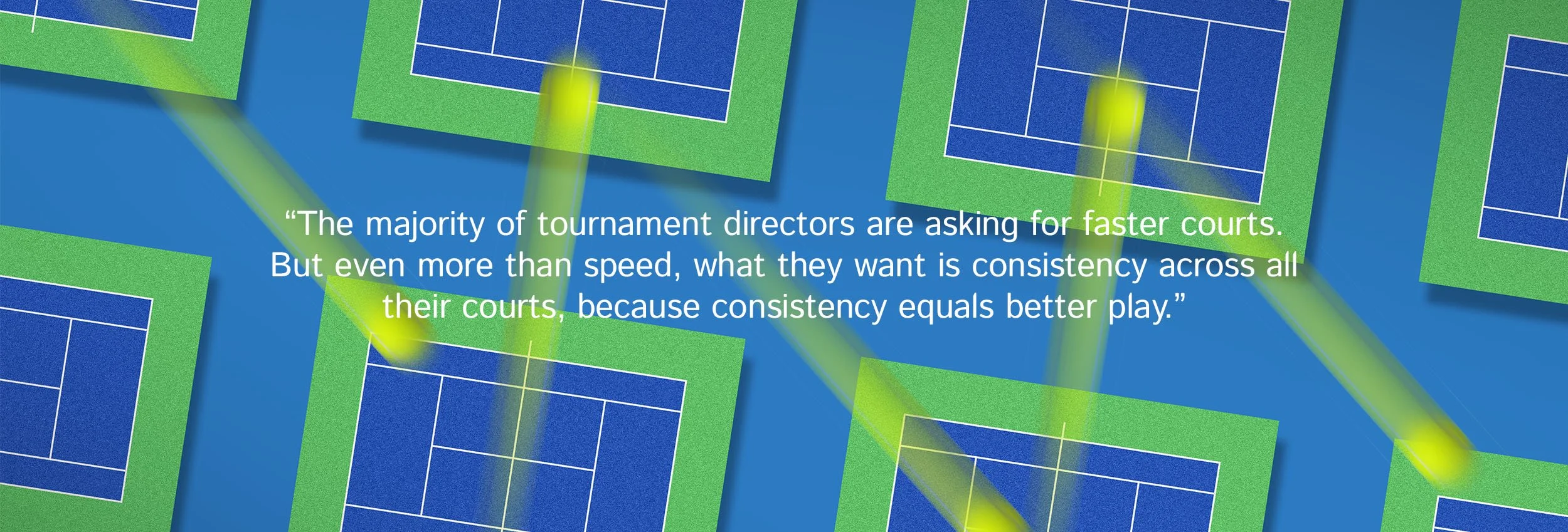Luke Burden on the tennis court pace and variety debate
Laykold’s former player, coach and tournament director explains why court pace variety and consistency is key to the game’s appeal.
Roger Federer raised an interesting debate on Andy Roddick’s Served podcast during the Laver Cup last week. His criticism of tennis for uniform, slower courts that favor Alcaraz and Sinner and his rallying cry to tournament directors to mix up the surface pace to keep matches unpredictable and exciting has, rightly, got the tennis world talking.
What’s the real impact of a court?
Court pace and consistency have been an obsession of mine for a while now. As a player and coach, I could feel a 1lb difference in racket tension, but the court had much less focus on it. Thanks to greater innovation and awareness, that is changing, and it’s been a huge area of R&D focus for us at Laykold. But is there still a knowledge gap in the actual impact the court has and how one court varies from the next?
The ‘same’ court pace certification may in fact be very different
To answer that we have to start with the debate over court pace ratings (CPR). I’ve been vocal about that here, but the point remains that we need tighter court classification so that when we compare or experience court pace, we can be more precise.
On paper, a court measuring a CPR of 35 and a court measuring 39 is considered ‘the same’. But in reality, they impact strategy, timing, muscle memory, string setup, and ultimately, fairness (not to mention the fan experience), very differently.
This is also different to the Hawkeye-measured CPI most people refer to when discussing court pace at a tournament. CPI, however, is not a reliable way to compare one venue to another, one court to another or even the same court day to day.
The pace between each Laykold tournament is rarely the same
Through advanced sand science, years of testing, and a high-quality, consistent product, our scientists have developed the ability to dial in court pace to within 0.5 of a point, unlike the CPR certifications which allow a 5–6-point margin.
This means that the pace between each Laykold tournament is rarely the same, even if, on the current CPR ratings, they are both a Medium (M3) or Medium Fast (MF4).
Tournament directors are requesting faster, not slower courts
Over the last three years I have worked closely with the tournament directors of many ATP and WTA 250, 500 and 1000 level events around the world, in addition to a whole host of ATP and WTA challenger and ITF World Tour events.
Across all these events, I have not received requests for slower courts; in fact, the majority are asking for faster courts. But even more than speed, what they want is consistency across all their courts, because consistency equals better play.
“Courts during a tournament shouldn’t be a random variable– in the same way players don’t want random ball performance or strings that change.”
Consistency within tournaments is the new ‘GOLD’ standard
Court speed has always been talked about, but now the discussion is not just pace, but the precision of pace. Courts during a tournament shouldn’t be a random variable– in the same way players don’t want random ball performance or strings that change.
But this doesn’t mean standardization across all tennis events
Standardization doesn’t have to mean identical court pace from one event to the next. Variety is an important part of the sport. I love watching how players adapt as the tour unfolds.
What we don’t want is variety as a by-product of inconsistent manufacturing or loose pace ratings. Instead, variety should, and can, be achieved with each tournament selecting the precise pace that best fits its identity, the needs of the players, the geographic and climatic conditions.
Challenger tournaments can benefit from recreating the big tournaments in their Swing
Some challenger tournaments (and even 250/500 level events) wish to recreate the conditions of the bigger events in the same Swing. The Laykold courts at the Cap Cana Open in the Dominican Republic and the Laykold surface at the Arizona Tennis Classic, for example, provide essential preparation for the Miami Open.
With 40 years of experience as the official court surface of the Miami Open, and the ability to secure an exact pace rating, Laykold is uniquely placed to recreate the Miami court experience in these springboard tournaments.
The benefit is that this allows the challenger players to come through more prepared to the sport’s big stages.
Precision makes perfect tennis
You only have to look to the Miami Open and Indian Wells in 2025 (Van de Zandschulp, Mensik, Griekspoor, Watanuki, Draper) to see that there is still room for upsets. And while there will be dominant players in every age, Federer’s included, the big tournaments are far from a foregone conclusion.
In my opinion it is the role of the surface providers to deliver Grand Slam quality courts that meet the individual needs and identity of each tournament exactly and not just meet the broad range afforded by the CPR certification ranges.
This precision and consistency within tournaments allows players to provide a great product, fans to be entertained and the game we all love to grow.
Read my opinion piece on CPR: Court pace classifications not fit for professional & college tennis.
Find out more about how Laykold tailors courts by tournament: Laykold delivers non-stop court consistency.

